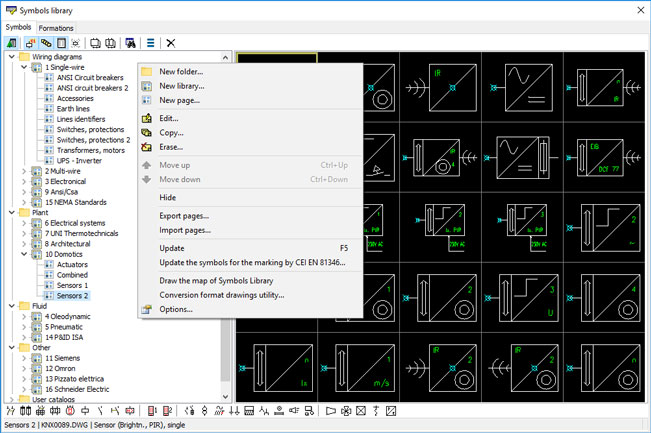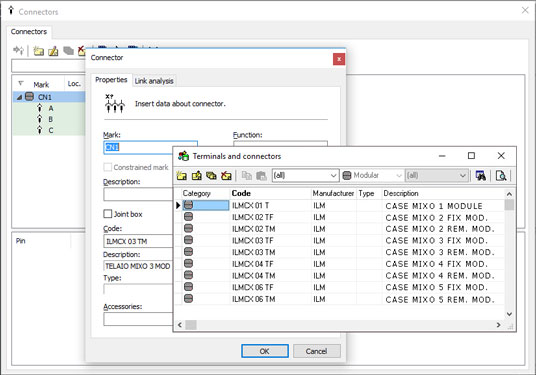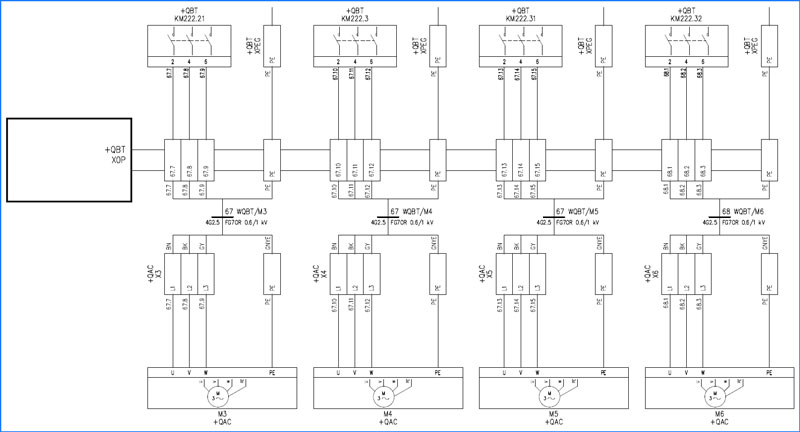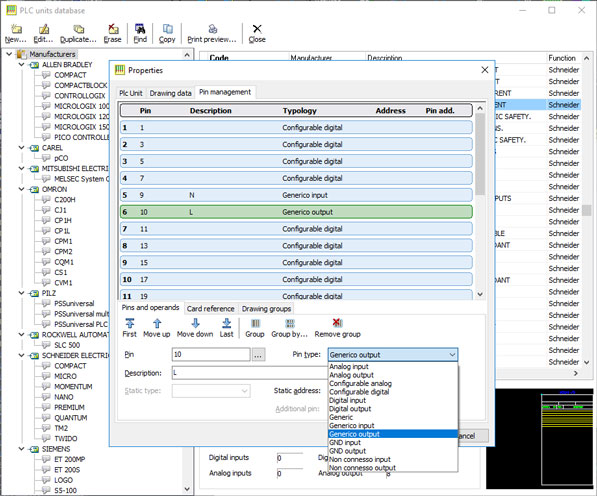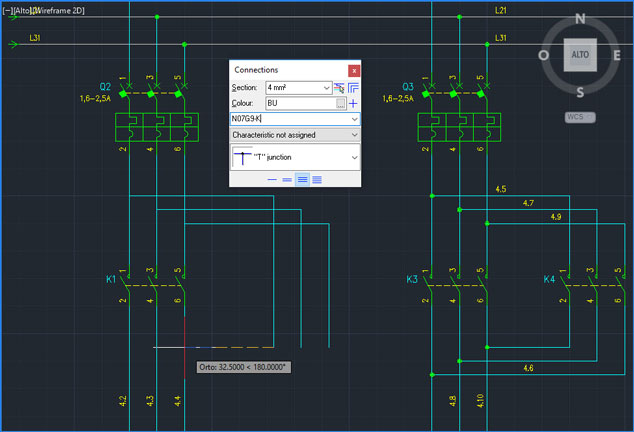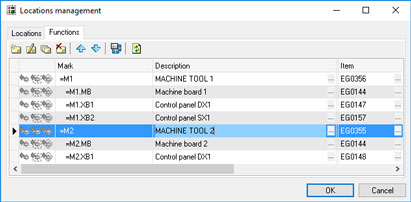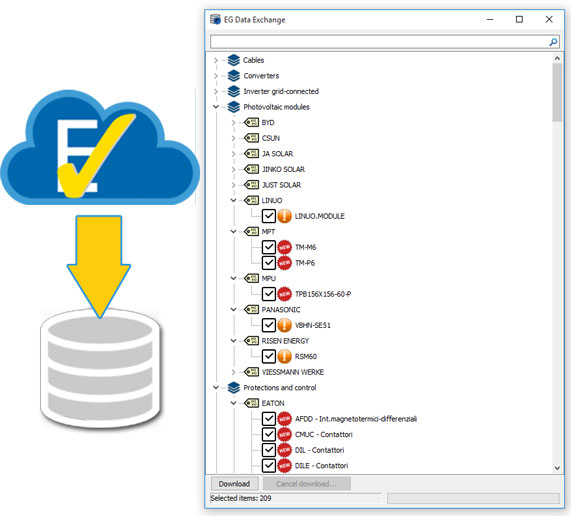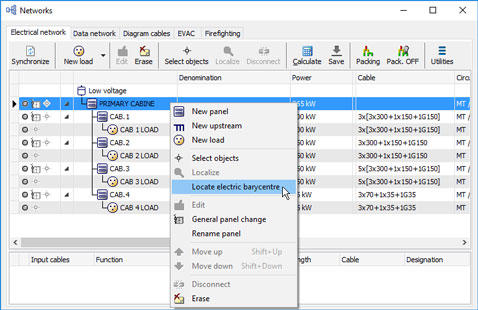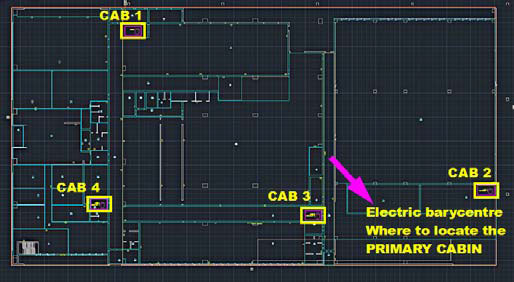New features 2019 Series - Electrical CAD
Electro Graphics releases the latest 2019 Series of electrical and photovoltaic design software. Here are the most important features and enhancements introduced in the electric CAD CADelet, iDEA, Eplus.
See all new features 2019:
New features in the management of symbol library and catalogs
In the Symbol Library you can now create folders with other folders inside, without limits, to organize the default and personal catalogs.
Within each catalog you can create new library pages where you can save symbols, as in previous versions, but now it is easier to edit the information, move and sort through drag & drop to organize the catalogs as you prefer.
Modular connectors, with case and inserts
The modular connectors are a type of electrical connection elements made available by some manufacturers that allow assembling inside a container, said frame, a set of appropriate connectors or plugs.
The management of connectors in the electrical CAD and in Cablo now allows to define the modular connectors as multiple connectors assembled to a frame, of which they assume the initials, location and function.
After tracing in the project, their aggregation is displayed in the Connector Detail Tables and the Connector list table.
Representation of the connection between terminal blocks and individual components or other terminal blocks, on several levels
The connection diagram of the terminal board (or connector)is a new representation of the upstream and downstream connections of a terminal board and the underlying levels; it can be traced automatically in the wiring diagram via the interface of Cablo 2019.
See also Cablo: News 2019
Management of PLC cards with types of operands that can be defined when inserted into the drawing
In the new Plc slots database it is now possible to define new types of Plc cards with operands that allow to be configured as input or output at the moment of insertion into the project.
Only when the board is assigned to a Plc project, in the presence of the new types of pin (digital configurable and analog configurable), the software asks to define their right type.
The cards can therefore be represented in the wiring diagram in their concentrated graphic form.
Improvements on wire drawing functions with automatic coupling to existing wires
With the new Wire command, drawing one-to-fourphase power lines, if you select a point near an already drawn wire, the line tracing ends by hooking up according to the desired type of connection (node, serial or parallel branch).
If the number of phases drawn is greater than one, the other lines will automatically identify the corresponding phases on which to connect.
Assignment of plant and machine information to functional groups, with relative typical coding
In the 2019 Series new functions of coding of the elements of the electric scheme are proposed, to meet the need that arises in some companies, to organize the materials used in a hierarchical structure codified and pyramidal.
It is now possible to create a free pyramidal structure of the Project Functions to represent the functional areas of a plant. Each defined function can be assigned an item code that represents the functional group within the company management system.
Even a group of sheets referring to a certain process, saved in the Sheet Library, can be coded with a single material code.
At the end of the drawing, the bill of materials of the scheme can therefore be optionally displayed as a list of unique codes for each machining or functional group as an alternative to the material codes of the individual components.
New EGData Exchange for downloading data packages, classified by manufacturer and series, containing the complete set of electrical device data (product, technical, schematic, dimensional, images and documentation)
Electro Graphics Data Exchange is the new tool for downloading update packages and integration of all Electro Graphics software database.
Installation in the database of data downloaded by EGData Exchange
EGData Exchange simplifies the search and installation of technical data useful for the design, reduces the time of distribution of database updates, centralizing the different types of product categories in a simple structure that communicates with the Electro Graphics server and real-time notification of the presence of new database packages.
Cables, connectors, protections, relays, families of symbols and many other types of data can transit through this system and be easily imported into the data files used by the Electro Graphics software, whether they are local or shared on the network.
Importing information of electrical devices from other formats
The new version of the Insert Eplan macro function, in addition to importing the .ema and .ems files, also allows importing .edz files. EDZ files, in addition to the elementary graphics of the block, can also contain the technical information of one or more material articles.
The merchandise data are saved in the article archive including code, description of the article and any images, technical data sheets and representation blocks on the wiring diagram and layout layout.
Reporting of accessory information on the protections on a single-line diagram
The Extractable type protection devices are now highlighted in the automatic single-line diagram with the appropriate symbology that identifies the extractability of the device. The drawing characteristic is based on a specific property present in the appliance data in the Protections database.
Recognition of equipment on a single-line diagram for multi-line point-to-point connections
The specification of multiple connection data within the pin of the devices inserted in a single-line diagram now allows to determine the individual point-to-point links in order to obtain the data for the connection and the marking of the wires in Cablo and the export of the plates for wires and terminals.
Representation of the connection diagram of the distribution panels in the plant electrical network
The synoptic management of the plant has been enhanced with a new function that allows to automatically draw the diagram of the frames defined in the utilities project elaborated in the Electro Graphics Ampère calculation software.
Determination of the electric barycentre of the loads defined on the planimetry, to optimize the positioning of the electrical panels
The electric barycentre of the loads defined on a planimetry is the point where the power absorbed by the entire plant can be supposed to be concentrated.
Positioning MV/LV cabins or points of electric supply near the electric barycentre, allows to obtain the best solution against voltage drops, power losses, cable length.
In Network Management, a function has been introduced that facilitates the identification of the electric barycentre of a booth or panel. The Locate electric barycentre command can be started from the context menu and can be executed after having placed booths, panels or loads in the floor plan immediately downstream of the cab to be positioned. An arrow-shaped indicator will indicate the optimal calculated position based on the powers and utilization coefficients involved.
Additional functionality in the management of networks for EVAC and fire fighting (point editing, loop closure and more)
The new Firefight and Sound diffusion EVAC use destinations for cable ducts and compartments have been introduced. The routing of the cables for these types of networks requires the correct setting of the new destinations in the data of the ducts of the design and in the relevant compartments. To this end, the new destinations of use are available in the tracing window of a conduit. Furthermore, in the editing window of a conduit, the software performs a consistency check on the use of the sub-funds in relation to what is defined in the predefined sub-sections in the Preferences.
Within the Networks interface, for EVAC and Firefighting networks, where the definition of serial chains of equipment is frequent, an element can now be moved upstream or downstream. The command is present in the context menu of the list after clicking with the right mouse button on an element.
The multiple editing of the elements for the Zone, Panel and Unit Type data was also enhanced.
Introduced the summary tables for EVAC and Firefighting networks. In all the Cables tables the Panel and Destination area information can now also be printed.
Panel layout with combined equipment such as circuitbreakers with releases and other accessories
When drawing combined equipment such as circuitbreakers with releases or other accessories, positioning on a DIN rail in the layout of the panel automatically considers the appropriate positioning direction.
Extension and updating of the formations, PLC, carpentry and devices database
All the database used by the Electro Graphics 2019 Series software have been reviewed, updated and integrated; in particular the Cables, Formations, PLCs, Carpentries archives and all the types of the family of the devices archives: Protections, surge protectors and overvoltage limiters SPD, UPS, Busbar trunking, Transformers, AC/AC inverter for motor starting, Inverter for photovoltaic systems connected in network, DC/AC inverter, Charge regulators, Optimizers for photovoltaic systems, Batteries, Photovoltaic modules.
Sharing of databasse packages
A new feature was created to allow the sharing of technical information of materials between stations or Electro Graphics products of different versions.
The Electro Graphics EGZ database package (file with .egz extension) contains material data and technical data specific to the type of material, which may include electrical data, shapes, images, associated documents.
EGZ packages will be published by Electro Graphics and made available for installation using the new EG Data Exchange tool. An EGZ package can also be exported from your Material database using the Export database package function, available in the materials archive window. And new EGZ packages can be imported directly into your Maerial database using the Import database package function.
See all new features 2019:




